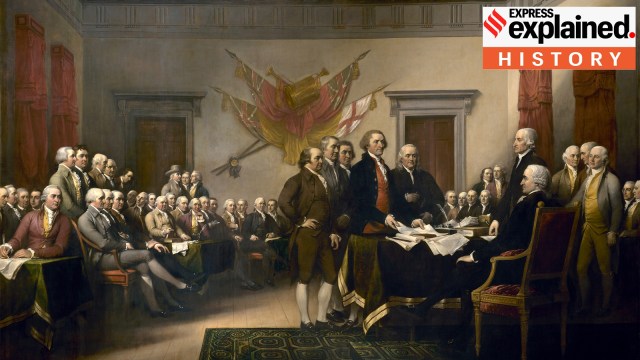Why the US celebrates its Independence Day on July 4
On July 2, 1776, 12 of the 13 member-states of the Congress “unanimously” observed that the colonies “are, and of right ought to be, free and independent states.”
 John Trumbull’s painting Declaration of Independence (1819). (Image source: Wikimedia Commons)
John Trumbull’s painting Declaration of Independence (1819). (Image source: Wikimedia Commons)The United States is celebrating its 249th Independence Day on Friday, July 4. This was the day in which the country’s founding fathers formally signed the Declaration of Independence, officially ending British rule over the colonies. Here’s a brief history.
Discontent with crown
More than 150 years after the first permanent British colonies emerged in North America, the colonists had grown increasingly frustrated with the Crown.
With the 13 original colonies having no representation in the British Parliament in London, the 1760s and early 1770s saw the passage of a series of laws which imposed high taxes and curtailed colonists’ activities.
Legislations such as the Sugar Act (1764), the Tea Act (1773) and the Intolerable Acts (1774) were seen by Americans as excessive British interference in their lives. With the Enlightenment giving a rise to ideas of freedom and equality, the situation was ripe for an uprising.
Boston Tea Party & beyond
On December 16, 1773, an anti-British group known as the Sons of Liberty destroyed a shipment of tea sent to Boston by the British East India Company.
The so-called Boston Tea Party began a resistance movement across the colonies against the oppressive tea tax — and the British Empire as a whole. The colonists claimed that Britain had no right to tax the colonies without giving them representation in the British Parliament.
To decide further course of action, the 13 colonies came together to form the Continental Congress. The Congress initially tried to enforce a boycott of British goods, and meet King George III to negotiate better terms. But their attempts were in vain.
This meant that by April 1775, all 13 colonies were fighting a full-blown war of independence against the British Crown.
This war went on till 1783 when Britain formally recognised American independence after its military defeat. The American victory, in no small part, was made possible due to the support of Britain’s European rivals — namely France, Spain, and the Dutch Republic.
Declaration of Independence
Years before 1783, while fighting still raged on, the Continental Congress declared American independence from British rule.
On July 2, 1776, 12 of the 13 member-states of the Congress “unanimously” observed that the colonies “are, and of right ought to be, free and independent states.”
As John Adams, who later became the second President of the US, noted: “The second day of July 1776, will be the most memorable epoch in the history of America. I am apt to believe that it will be celebrated by succeeding generations as the great anniversary festival.”
He was off by two days. The formal document solemnising the colonies’ independence — the Declaration of Independence — was signed on July 4, the day that is still observed in the US as Independence Day.
The Declaration read: “We hold these truths to be self-evident, that all men are created equal, that they are endowed by their Creator with certain unalienable rights, that among these are life, liberty and the pursuit of happiness.”
- 01
- 02
- 03
- 04
- 05






































